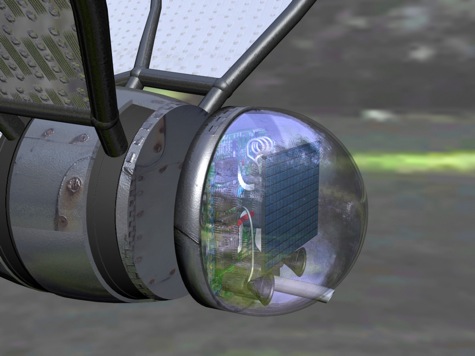
If you're like me, at this time of year, your thoughts turn to people you've lost touch with and would like to see. Perhaps there's someone who, last you heard, was hiding in a subterranean network of caves in eastern Afghanistan. You'd go there and search for him, but you'd likely be shot by guards or turned to mist by a booby trap.
One solution might be sending in the six-inch-long robotic micro-aerial vehicle known as the Com-Bat. In concept the Com-Bat is similar to the radio-controlled toys on children's wish lists this holiday season. A significant difference is it can fly autonomously, powered by its own self-recharging lithium battery. Also, with a lifelike outer layer of bat fur and features, and the realistic manner in which it flaps its wings, lands and perches, it would probably fool real bats, let alone men. In addition, it's able to transmit what it sees and hears to you in real-time, from miles away.
The Com-Bat can even smell, effectively. Dr. Kamil Sarabandi, the electrical engineering and computer science professor who is directing its development, told me, "It can detect chemical warfare agents and nuclear radiation."
In March, the Army gave Sarabandi and his University of Michigan team a five-year, $10 million grant to turn the concept into battle-ready reality.
Sarabandi's greatest challenge has been the drastic miniaturization of almost every component. The radar unit, for instance, will have to weigh less than twenty-five grams (the approximate weight of a standard AA battery), which Sarabandi readily acknowledges, "is science fiction." Now. The Michigan engineers are learning from nature, however. "We have been copying what bats are doing in terms of echolocation for navigation in the dark and collision avoidance."
Another hurdle is extending the Com-Bat's range. Present technology allows flights of twenty minutes to one hour, during which time the device covers a maximum of ten miles. The Army's goal is 100 miles.
Nevertheless, Sarabandi says, "I hope to have a working prototype in five years."
One criticism of the Com-Bat is, ironically, its resemblance to a bat--bats aren't exactly inconspicuous. Sarabandi shrugs this off, saying, "We can make it look like a bird too."
Another concern is cost. Scientists at the University of California at Berkeley, the University of New Mexico and the Army Research Laboratory are also involved in the project. Given certain scenarios, the price of a Com-Bat prototype could reach $22.5 million. Sarabandi makes a compelling argument that that would still be a bargain: At that juncture, "Com-Bats could be produced inexpensively, just a few hundred dollars apiece." Or less than a typical soldier's sidearm.
Com-Bats may well wind up on holiday wish lists a few years from now.
Here's hoping Osama bin Laden gets one sooner.

